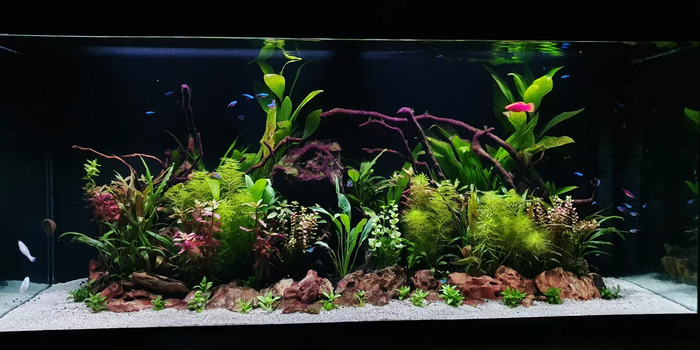Contrary to popular belief, there are many different types of aquarium plants. Aquarium plants are plentiful and in high demand because people are looking for ways to spice up their homes with beautiful aquariums.
Aquarium plants make an aquarium look more appealing and consume toxic nitrogen compounds, a by-product of fish waste. If you are looking for the best aquarium plants but do not know where to begin, you are at the right place. In this blog, you will find the top 10 aquarium plants for beginners. Without further ado, let’s dig in.
The best aquarium plants for beginners
The following plants should be made a part of your most desired aquarium plants list to add the much-needed beauty to your space.
Amazon Sword
This is one of those beginner aquarium plants which are recognized for their propensity to grow enormously large and cover your fish tank in lush beauty. You need to feed them with a huge number of root tabs. When these enormous leaves are submerged in water, they melt back as the plant reabsorbs its nutrients, resulting in longer, narrower leaves.
If the new leaves seem to fade, give the plant additional root tabs, and it will prosper. The sword may eventually grow large enough to become a mother plant, producing long spikes that may be transplanted to other tanks.
Aponogeton Crispus
This low-light plant’s long, wavy-edged leaves grow from a bulb and flow elegantly in an aquarium. Because it is so simple to care for, this is one of the most popular species offered as a “betta bulb” at pet shops. Set the bulb on top of the substrate and watch it produce leaves and roots almost immediately. It sometimes passes through a dormant phase where the bigger leaves die back for a few months. Keep the plant in the tank, and fresh growth will appear once more. So definitely check them out, as they are cheap, grow quickly, become pretty tall, and can even produce flowers for you.
Christmas Moss
Get some Christmas moss if you’re putting up a breeding tank. Their fluffy fronds resemble Christmas trees and offer excellent protection to young fish and shrimp. Aquascapers often tie them to rocks and driftwood to create the appearance of a moss-covered forest. Invest in little algae eaters like Amano shrimp and encourage their development with liquid fertilizers to keep these slow-growing moss looking their best.
Java Fern
Java moss and java fern get their name from an Indonesian island. While these aquarium plants are easy to care for, they differ significantly in appearance.
The java fern comes in various shapes and sizes, including thin leaf, Windelov, and trident, but the most common type has long, pointed leaves with highly ridged veins. Avoid planting the rhizome into the substrate because the rhizome (a thick, horizontal stalk or stem) sprouts all of the plant’s leaves and roots. Most people squeeze the plant into rock and wood cracks, where the roots gradually encircle it. You may alternatively use super glue gel or sewing thread to keep the plant in place.
Dwarf Sagittaria
Do you need a simple carpeting plant to finish your aquarium? Dwarf Sagittaria is a hardy, grass-like plant that resembles a small Vallisneria in appearance. It remains small and short when exposed to strong light, but it grows rather tall when exposed to low lighting to get closer to a light source. It likes both root tabs and liquid fertilizers in the water column for nutrition. Dwarf sag spreads quickly by sending out runners all over the substrate. Pull off the new branches and transplant them elsewhere if they grow to an undesirable tank section.
Marsilea Minuta
Because of its tremendous carpeting ability, Marsilea Hirsuta is an appealing ground-cover plant. It grows slowly, remains compact at just a few inches/centimeters tall, and spreads its prolific runners to form thick, appealing carpets.
Marsilea Hirsuta is one of the best aquarium plants for beginners since it thrives in low light and does not require CO2. This aquarium plant is predominantly found in Australia’s floodplains, ponds, and marshes. It may grow partly or fully submerged in shallow, standing waters on sandy or clayey soils as an aquatic plant. The plant has been introduced to parts of North America and Europe in recent years.
Anubias Nana
Anubias nana is a tiny plant with broad leaves. Although many aquarium plants come from Asia, this species is unique to Africa. It’s a beautiful dark green plant that will help keep the water in your tank clean and oxygenated.
Adding plants to an aquarium might be scary for novices since it adds another item to look after. The good news is this plant is durable and will not wither away if you make a blunder. You will be pleased to know you will not have to put in a lot of effort in keeping it up since it grows slowly; a simple trim will suffice. It’s very easy to spread, so you may start small and progressively to spread it around your tank.
Green Hygro
Green Hygro is a fast-growing stem plant with long leaves that change color depending on sunlight. Choose a well-planted aquarium substrate since this plant demands a large substrate to attach its roots. Browning should be avoided by using low lighting.
In certain states, Green Hygro is considered a weed. In other places, it is prohibited owing to the plant’s quick expansion. Ensure to check with the local regulations before buying the Green Hygro for your tank.
The Green Hygro is a prolific plant that may quickly outgrow its container if the environment is in its favor. CO2 supplements may also be beneficial, although they are not necessary.
Sunset Hygro
A near cousin of the Green Hygro is the Sunset Hygro. It is distinguished mainly by the color of the leaves. The Sunset Hygro has red-pink leaves with white veins. It, like the Green Hygro, requires regular pruning. Pruning shears or pinching off new growth by hand are also options for pruning. In addition, the water must contain sufficient iron levels to upkeep the leaves’ brilliant red colors. Both red and green varieties make great indicator plants in low-light aquariums. When nutrient levels or other problems arise, they tend to drop their leaves, suggesting a problem.
Hornwort
The Hornwort gets its name from the shape of its leaves, which has earned it the nickname “Coontail.” The leaves form a tangle of stems resembling a bushy tail extending outwards. Because it lacks true roots, the Hornwort is a beautiful green plant that does not need a firm base. It will cling to aquarium fixtures or float freely in the water. Hornwort thrives and serves as an excellent nursery for juvenile fish.
Final Words
The list of aquarium plants for beginners mentioned above is worth checking out and is especially handy if you do not know where to begin. Be sure to fill your aquarium with a curated collection of easy to grow aquarium plants from Koi Kampanion, and you will indeed realize that your investment was worth it.




